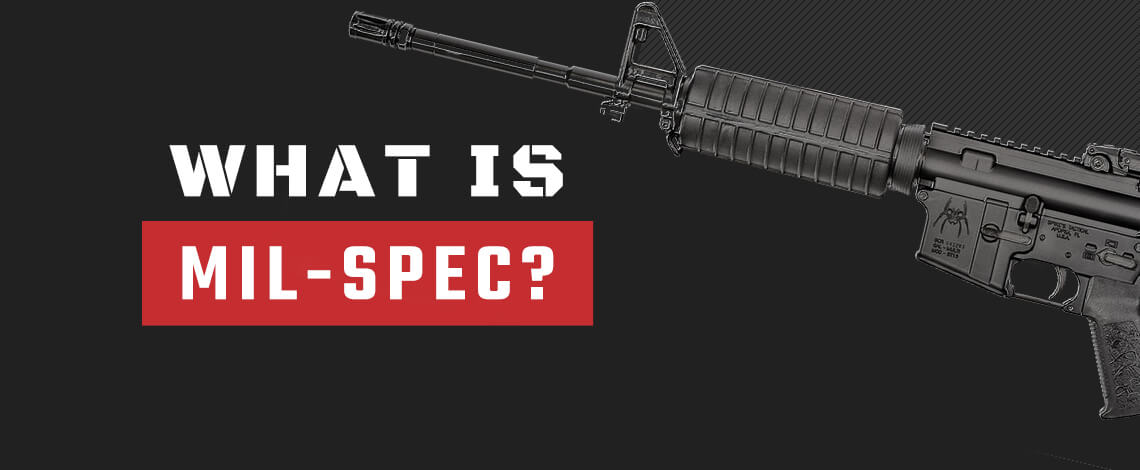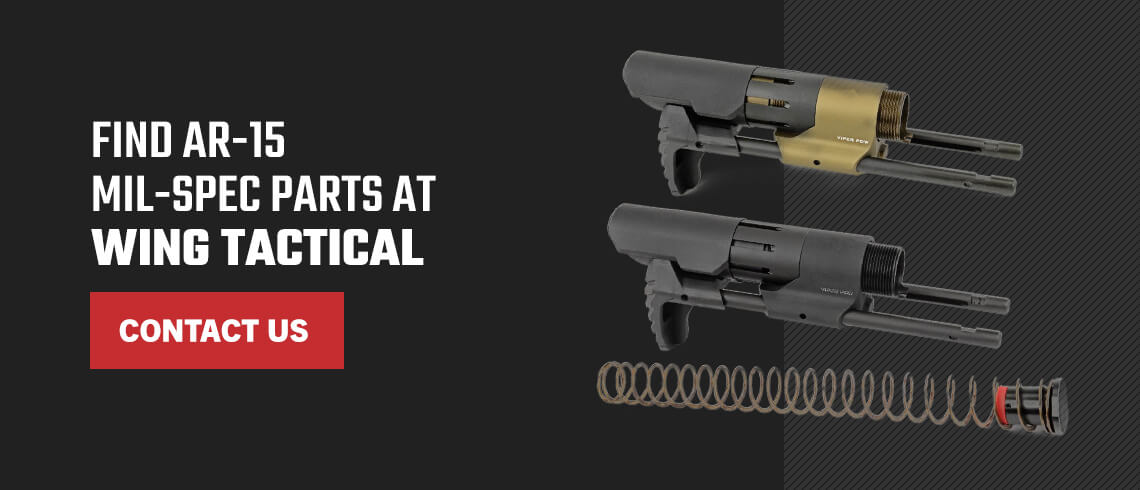
For years, shooters have been told that this firearm is “mil-spec” or that part is “mil-spec”, but what does that mean… what is a mil-spec AR-15? “Mil-Spec” is a term that refers to Military Specifications or standards. More to the point, any firearm made for the U.S. Military is Mil-Spec and the only firearms that are truly Mil-Spec are made for the U.S. Military. Anything that is “mil-spec” is required to be held to specific standards, made of specific materials, made to specific tolerances, pass government level inspections and testing, and received mil-spec certifications stating that the firearms meet the Military Standard or “Mil-Std”. Each of these standards are specified separately and each one is done so in meticulous detail. This is done to maintain compatibility between firearms platforms and their parts. As we talked about earlier, only the military has mil-spec AR-15s or M-16s, so actually owning a completely mil-spec AR-15 is not going to happen. However, you can own an AR-15 with mil-spec parts in it. We will cover some of the most common parts now.
The Buffer Tube
There are a few ways to ID the mil-spec AR parts in each platform. The receiver extension or “buffer tube” of a mil-spec tube is a different diameter than the commercial receiver extension or buffer tube. The mil-spec buffer tube is 1.148” +/-inches in diameter whereas the commercial buffer tube is 1.168” +/- inches in diameter. Not a huge difference, only about .020” +/- of an inch (twenty thousandths) but enough to make a difference. Both receiver extensions/buffer tubes have a 1-3/16”-16 TPI thread pattern, but both are not made equal. The commercial version was designed and made to offer a cheaper overall product to the end user, so its usually made of extruded tubing with a welded end cap. On the other hand, the mil-spec buffer tube is machined completely from 7075-T6 aluminum, all one piece. Some commercial buffer tubes are angled at the end, as opposed to the mil-spec version which is always flat at the end. Some commercial length buffer tubes have an increased overall length, and the mil-spec versions are always the same length.
The Bolt Carrier Group
The bolt carrier groups differ as well, but with regards to full auto (remember earlier we talked about the full auto M-16 being mil-spec) or semi auto. The rear portion of each bolt carrier group is machined differently. The top of the rear part of the full auto BCG is identical in length to the lower lug portion of the rear of the BCG. The semi auto BCG has the same length upper rear portion as the full auto BCG. But the rear lug on the underside of the semi auto BCG is machined to a shorter length than its full auto counterpart. Another aspect is the type of steel used in the bolt itself. Mil-spec bolts are made of Carpenter 158 steel, which was the standard set forth by the original M-16 manufacturing blueprints and specs. Additional mil-spec standards for the BCG are Grade-8, staked hardware on the bolt carrier’s gas key, High Pressure and Magnetic Particle Inspection of the BCG, and a shot peened outer finish.
The Barrel
Another part of the AR-15 or M-16 to consider is the barrel. The chamber of a mil-spec AR-15 or M-16 is 5.56x45mm or 5.56 NATO, whereas a commercial AR-15 barrel can have a .223 Remington chamber, or a 5.56 NATO chamber. The length of a mil-spec AR-15/M-16 barrel is 14.5” whereas the legally required barrel length for a rifle in the USA is 16” inches. In many barrels, you will see a twist rate of 1:9”, 1:8”, and 1:7”. In case you don’t know, these numbers refer to the number of revolutions a bullet makes white travelling through the barrel. Therefore 1:7” twist means the bullet makes 1 revolution every 7”, so a bullet will rotate two full times travelling in a 14” barrel. One of the mil-spec standards on the barrel I want to mention is at the rear of the M4 barrel. The feed ramps of the smaller profile M4 are cut differently than the M-16A2 feed ramps. The M4 feed ramps are cut further down into the barrel extension and the cut extends into the upper receiver, whereas the M-16A2 rifle does not have the Mil-Spec M4 feed ramps. And finally, even though many barrel finishes and coatings exist on the market, mil-spec AR-15/M-16 barrels are always going to have a Parkerized finish.
The Trigger Group
An AR-15 trigger group includes the trigger, hammer, and firing components. It plays a pivotal role in your shooting experience, contributing to accuracy, speed, and ease of firing. Trigger groups labeled as mil-spec also tend to be the most common, although this is something of a misnomer — a true military trigger will have automatic firing capability and is therefore not available on the civilian market.
What we know as Mil-Spec triggers for the AR-15 are configured with the trigger and hammer as two separate pieces, accompanied by the disconnector, springs, and pins.
These triggers have a heavier pull-weight — typically in the range of 5.5 to 8.5 pounds — and a long pull, which helps prevent negligent discharge (ND) and protect against potential liabilities. However, these characteristics are not ideal for accuracy, which is why many shooters make an aftermarket trigger one of their first purchases when accurizing an AR-15.
Why Use Mil-Spec Components?
Using Mil-Spec parts offers numerous advantages. First and foremost, many Mil-Spec parts tend to be highly durable. For example, Mil-Spec upper and lower receivers are machined from 7075-T6 aluminum alloy, which makes the firearm exceptionally strong.
Mil-Spec barrels are also extremely strong, featuring a chrome lining that provides extra durability and corrosion resistance. What's more, Mil-Spec barrels have a Parkerized finish, giving the rifle additional protection against corrosion and wear.
Mil-Spec components are also fairly versatile. For example, Mil-Spec buffer tubes give you more options for aftermarket upgrades, providing a higher level of customization.
Ultimately, a part being designated as Mil-Spec does not necessarily mean it's the “best” available, but it does mean the part has been designed and tested to meet specific military standards. As such, you can trust that those components are of good quality and will provide the reliability that you want as part of a high-performance firearm.
Longevity of Mil-Spec AR-15 Parts
In conclusion, many other Military Specifications for the AR-15, M-16, M4 and their variants exist, but there are far too many tolerances, materials, measurements, and far too much technical data to cover in just one article. Even though it had a slow start and went through numerous changes, the AR-15 has outlasted countless other designs and has spawned multiple versions. Whether it’s a mil-spec AR-15, defining what mil-spec is, or identifying what parts are mil-spec, the AR-15 is truly America’s rifle, and will continue to be for many years to come.
Find AR-15 Mil-Spec Parts at Wing Tactical
Wing Tactical is your trusted source for AR-15 Mil-Spec parts. Whether you're looking to build a new rifle or replace components on your existing AR-15, we have a wide selection of Mil-Spec parts for all your needs.
We carry Mil-Spec parts from top brands like Spike's Tactical, Noveske, and Aero Precision, so you can trust the quality of our products.
When you buy from us, you'll also benefit from 30-day hassle-free returns and next-day shipping options, which means you'll get the parts you need fast.
Get in touch with us today about finding the best mil-spec parts for your AR-15 build. Our team of experienced shooters can help you select the right components for your needs.

